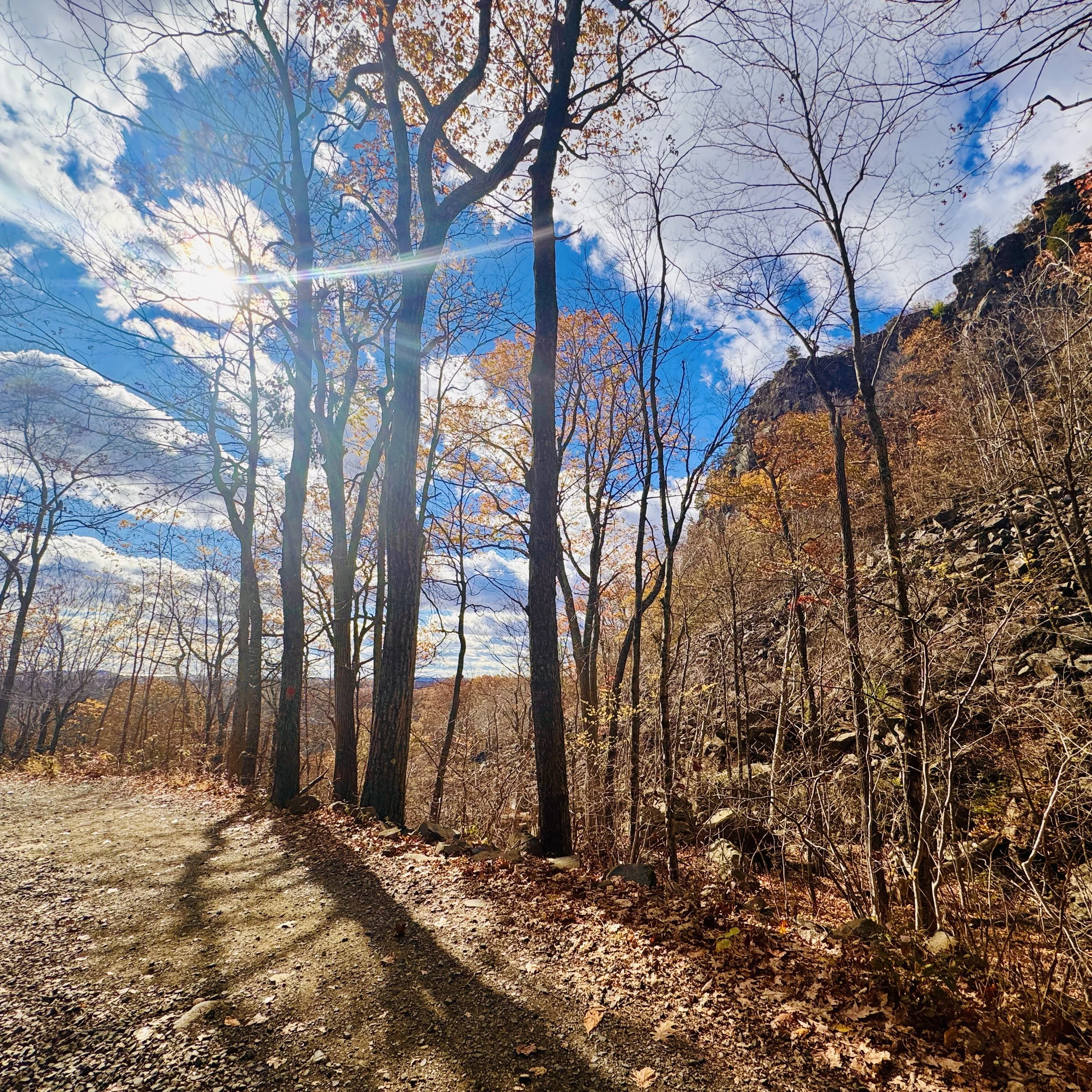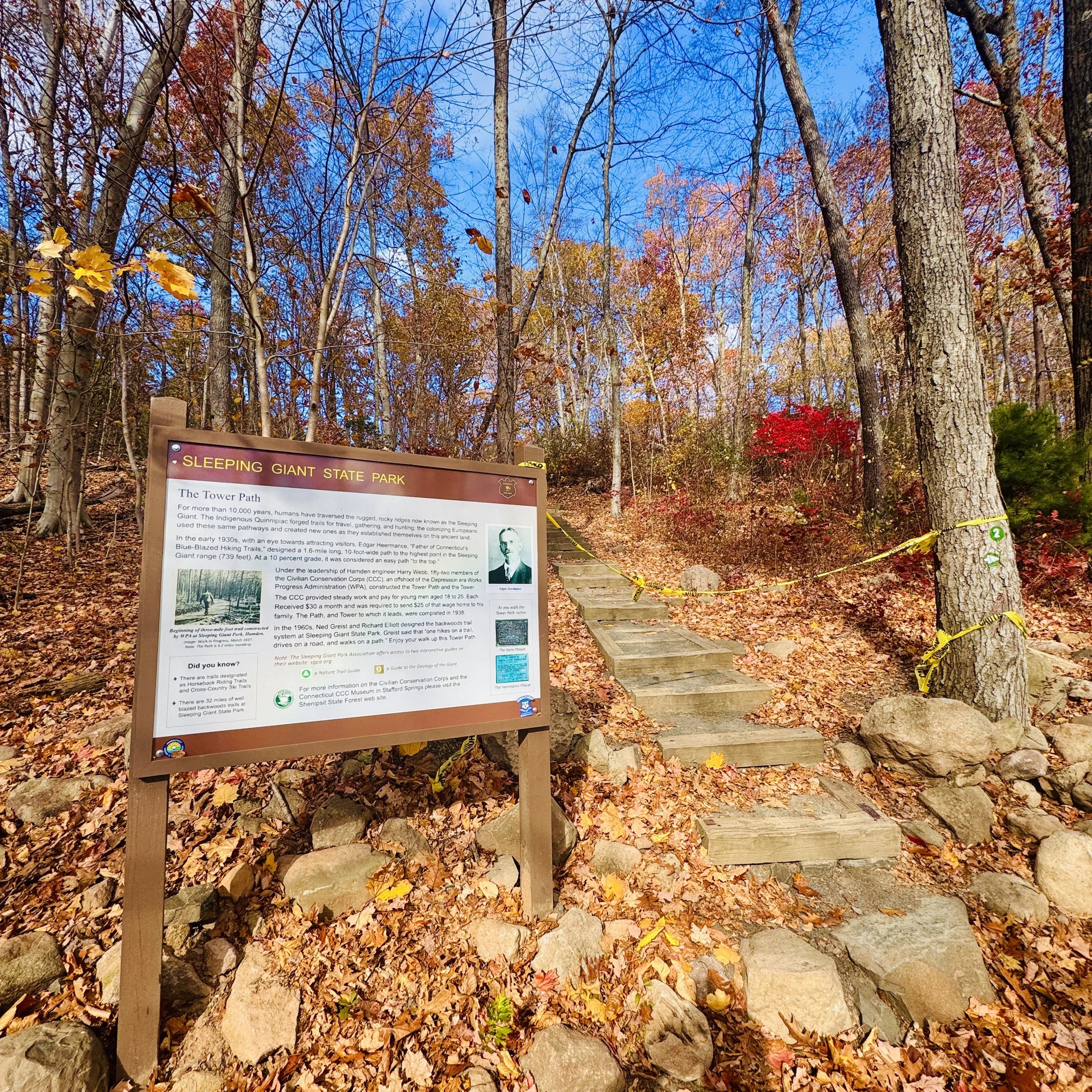Sleeping Giant State Park: The Trail for a giant, of course
My view from the mountain top
There’s something about a trail that looks peaceful from the parking lot but slowly turns into a test of your ankles, lungs, and back. That is what the Sleeping Giant Nature Trail in Hamden, Connecticut is—pretty at first glance, then quietly humbling.
I started the loop at around 9:00 a.m. with no big plan besides “walk, breathe, maybe take a few photos.” By the end, my apple watch said I’d been on that mountain for 1 hour, 43 minutes, and 45 seconds, and my legs definitely agreed. The name “Sleeping Giant” makes sense once you’re in it—it’s not one big hill, but a whole line of ridges and dips that make you feel like you’re walking across the back of something alive and slightly annoyed you’re there.
View from the winding hilly trail leading you up to the mountain top.
The first fifteen minutes were already tough. Beginning at point A, you’re immediately at an incline. gentle enough: a shaded dirt path, loose leaves underfoot, a few small rocks that make you pay mild attention. Then the terrain shifts. The ground becomes patchy with stone, and roots start forming natural steps. Every few turns, you hit a stretch where the incline sneaks up on you. Nothing extreme, just steady enough to make you stop pretending this is a casual stroll.
Halfway through, the “rocky part” appears. It’s not an official climbing wall—let’s be clear—but the face of the mountain there tilts in such a way that any adventurous hiker could be tempted to test their grip. You don’t actually need to climb it; the main trail curves along the side, but that section feels more vertical than it probably is. The rocks are solid basalt, dark and ridged from the ancient lava flow that created this whole ridge system. You can see layers like pages in a book written in stone—Connecticut’s quiet brag about its volcanic past.
Depending which way you go—there are two main routes to the top—you’ll either take the steeper, shorter approach or the winding, scenic one that gives your calves time to debate quitting. I tried both. The steeper path is quicker but demands focus; the looser gravel, muddy and slippery leaves, and jagged footing make it easy to misstep if you’re not paying attention. The longer route, on the other hand, threads through a small pine stretch where the smell of needles and soil feels almost alpine. It’s slower, calmer, and gives you more time to notice how the light hits each bend. At least the large boulders (jagged-edged) are easy for you to hold a grip on once your go up the mountain. Nice little obstacle course.
Taped off steep stairs at the entrance of the trail
By the last quarter mile, you feel the air change. The canopy opens, and the sound of leaves fades into that mountain quiet—the kind where you can actually hear your heartbeat syncing with your pace. The wind was quite strong. It made me feel like I needed to hold on to a tree so the gust of wind doesn’t blow me off. The summit isn’t Everest, but when you reach the lookout tower, it feels like an earned pause. From up there, the surrounding valleys roll out like patchwork, with the Quinnipiac River glinting in the distance.
I sat for a while at the top, leaning against a rock, the kind of tired that feels earned rather than drained. There were a few other hikers—some chatting, students who went there for a field trip, all acting silly and complaining about the challenge, and some just staring out. Everyone seemed to have gone through the same quiet endurance test: pushed up the ridge, slowed by the terrain, rewarded by the view.
The way down is its own challenge. Gravity becomes both friend and foe; it helps you move faster but asks for more balance. The loose stones that were minor annoyances on the way up suddenly become slick reminders to stay alert. My total time—1:43:45—included every water break, photo stop, and one short moment where I considered calling the trail “moderate” an understatement.
Sleeping Giant isn’t a casual walk; it’s a full-body workout. You feel it in your feet, knees, and the small muscles in your back that don’t usually get invited to hikes. But the terrain has character—it’s challenging without being punishing, wild without being unsafe.
If you ever go, bring water and shoes that don’t mind getting scuffed. Perhaps gripped hiking boots. Choose your route depending on your mood—short and steep if you need to sweat out your thoughts, or long and winding if you want time to think them through. Either way, you’ll come down different than you went up.
And maybe, like me, you’ll realize that sometimes the best views are the ones you had to argue with the earth a little to earn.
I also wrote a blog post about the leaves I found that were unique and vibrant. Read the blog here.
call to action!
“What hikes have you been on lately that are noteworthy? Does this trail Sleeping Giant Trail sound intriguing?”









